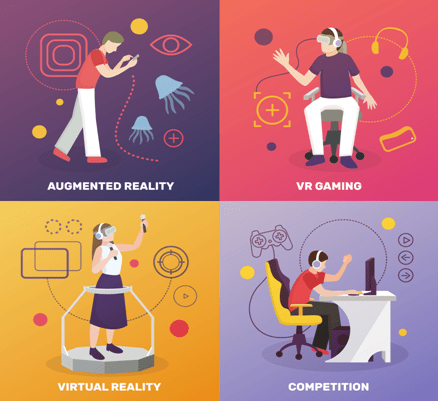Introduction to Virtual Reality:
Virtual reality, often referred to as VR, is an artificial environment meticulously crafted through software. This virtual world is presented to users in such a way that it encourages them to suspend their disbelief, accepting it as real. When it comes to the realm of computers, VR primarily engages two of our five senses: sight and sound. In essence, virtual reality involves immersing our senses in a computer-generated world that we can explore to some degree. Let’s dive deeper into this captivating technology. AbhinavDCS specializes in crafting cutting-edge virtual reality experiences that push the boundaries of innovation and immersion.
History of VR (Virtual Reality)
Early attempts at virtual Reality.
Panoramic Paintings.


If we narrow down our focus to the core concept of virtual reality, which is to create the illusion of being somewhere you physically aren’t, then one of the earliest endeavors in virtual reality undoubtedly lies in the 360-degree murals, also known as panoramic paintings, dating back to the nineteenth century. These mesmerizing artworks were meticulously designed to envelop the viewer’s entire field of vision, effectively transporting them to distant historical events or captivating scenes, pioneering the immersive experiences we associate with modern virtual reality today.
1838 – Stereoscopic photos & viewers
In 1838, Charles Wheatstone’s groundbreaking research unveiled how the human brain processes two-dimensional images from each eye, forming a three-dimensional perception.
As time passed, we got better at exciting our senses. The 20th century, with its electronic and computer advancements, was a game-changer.
1930s – Science fiction story predicted VR
In the 1930s, author Stanley G. Weinbaum imagined goggles that could transport users into fictional worlds, engaging all their senses. This foresight hinted at the future of immersive technology.
1950s – Morton Heilig’s Sensorama
During the mid-1950s, cinematographer Morton Heilig gave life to the Sensorama, patented in 1962. This arcade-style theater cabinet went beyond sight and sound, immersing users with stereo speakers, stereoscopic 3D display, fans, smell generators, and even a vibrating chair. It was a pioneering leap into multi-sensory experiences.
1987 – Virtual reality the name was born
1989 – NASA Gets Into VR
1993 – SEGA announce new VR glasses
1994 – The Sega VR-1
2007 – Google Brings Us Street View
2010 – Street View Goes 3D and the Oculus is Prototyped
2014 – Facebook Buys Oculus and Sony Announced their VR Project
2018 – The Half-dome HMD is Announced
2019 – VR is Shifting Rapidly
Importance of VR in today’s world.Your Content Goes Here

Education and Training:
VR revolutionizes education by providing immersive learning experiences. It allows students to explore historical events, complex scientific concepts, and practical skills in a captivating and interactive manner. In professional training, VR offers realistic simulations for tasks ranging from surgery to aviation, enhancing safety and expertise.
Entertainment and Gaming:
VR has transformed the entertainment industry. It offers gamers unparalleled immersion, enabling them to step into virtual worlds and interact with digital environments. Beyond gaming, VR enhances cinematic storytelling and brings new dimensions to art and creativity.
Healthcare Advancements:
VR plays a crucial role in healthcare. It aids in diagnosis, treatment, and therapy. Surgeons can practice complex procedures in a risk-free virtual environment, and patients benefit from VR therapy for pain management, anxiety, and rehabilitation.
Architectural Visualization:
Architects and designers use VR for 3D modeling and
virtual walkthroughs, allowing clients to visualize and approve designs before construction begins. It streamlines the planning process and reduces costly revisions.At AbhinavDCS, our mission is to enhance the realism of 3D designs.
Remote Collaboration:
VR enables remote teams to collaborate effectively. Virtual meetings and shared spaces break down geographical barriers, fostering innovation and teamwork.
Military and Industrial Training:
VR is instrumental in military training, offering realistic simulations for soldiers. It also provides a safe environment for industrial workers to practice dangerous tasks and emergency procedures.
Therapeutic Benefits:
VR therapy is increasingly used for mental health treatment, including exposure therapy for phobias and post-traumatic stress disorder. It also aids in pain management and cognitive rehabilitation.
Scientific Research:
Researchers use VR to visualize complex data and conduct experiments in virtual environments, facilitating scientific discovery and innovation.
Future Innovations:
As technology advances, the potential applications of VR continue to expand. Mixed reality experiences, medical breakthroughs, and new educational paradigms are on the horizon.
How Virtual Reality Works?
- VR Hardware:
-
- Headsets: VR headsets are the primary hardware components. These headsets are worn on the user’s head and have high-resolution displays for each eye, providing a stereoscopic 3D view of the virtual world. They often include gyroscopic sensors, accelerometers, and magnetometers to track head movements accurately.
-
- Controllers: VR controllers are handheld devices that enable users to interact with the virtual environment. They can mimic hand movements and gestures, enhancing the user’s ability to manipulate objects and navigate the virtual space.
-
- Sensors: External sensors or cameras are used to track the user’s movements within a physical space. This tracking allows for room-scale VR experiences where users can move around and interact with objects in the virtual world.
- VR Software and Content Creation:
-
- Software: VR experiences are powered by specialized software that creates and renders the virtual environments. This software ensures that the virtual world responds to the user’s actions and movements in real-time.
-
- Content Creation: VR content is developed using 3D modeling, animation, and programming. Content creators use tools to design and build virtual environments, characters, and interactive elements. This content is optimized to run smoothly at high frame rates to maintain immersion.
- Immersion and Presence in VR:
- Immersion: VR aims to immerse users in a digital environment that feels real. High-quality visuals, spatial audio, and responsive interactions contribute to immersion. Users often report feeling as though they are physically present in the virtual world.
-
- Presence: Presence is the sensation of “being there” in the virtual environment. It’s the feeling that the virtual world is so convincing that users forget about their physical surroundings. Achieving presence is a key goal in VR development and relies on realistic graphics, low latency, and accurate tracking.
How virtual reality makes your daily life better:

- Entertainment:
- VR offers immersive gaming and entertainment experiences. You can escape into virtual worlds, explore new adventures, and interact with digital environments, providing a fun and engaging way to unwind.
- Education:
- VR can enhance your learning experiences. Whether you’re a student exploring complex concepts or an adult looking to acquire new skills, VR provides interactive and engaging educational content.
- Fitness:
- VR can make exercise more enjoyable. Fitness apps and games in VR can motivate you to stay active by turning workouts into engaging experiences.
- Social Interaction:
- VR allows you to connect with friends and family in virtual spaces. You can meet up with loved ones, attend virtual gatherings, or even engage in collaborative activities together, bridging geographical gaps.
- Mental Health:
- VR can be used for relaxation and stress relief. Guided meditation apps and calming VR environments can help you unwind and manage daily stress.
- Exploration: VR enables virtual travel and exploration. You can visit iconic landmarks, museums, and exotic destinations without leaving your home, broadening your horizons.
- Creativity: VR provides tools for artistic expression. You can create 3D art, design virtual spaces, and experiment with digital creativity, offering a unique outlet for self-expression.
- Training: VR is valuable for skill development. Whether you’re learning a new instrument, practicing public speaking, or acquiring technical skills, VR simulations can accelerate your progress.
Start your journey with Virtual Reality now:-
Google WebApp – https://developers.google.com/vr .







